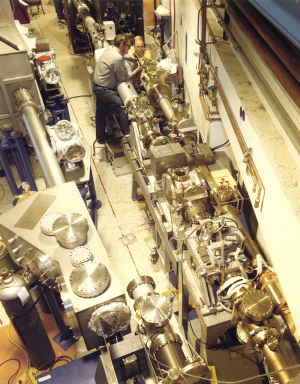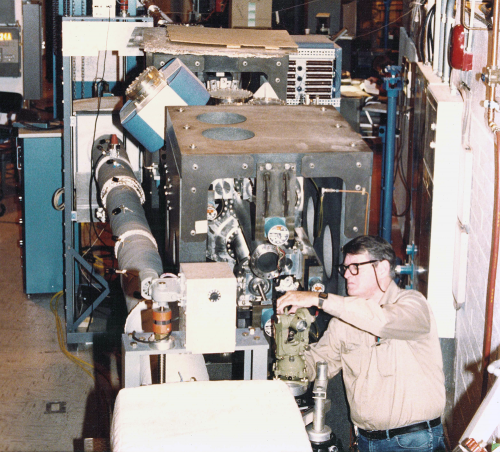New instrument brings long-sought improvements to EUV testing and calibration
![Schematic diagram of X24c principal components, not to scale. [1] The monochromator uses a system of precision mirrors and gratings to select only one wavelength from the incoming beam source (bottom left) and route it to the instrument's exit slit (top right). [2] The reflectometer components can position a sample at any desired orientation to the EUV beam and to the detector. New instrument brings long-sought improvements to EUV testing and calibration](https://scx1.b-cdn.net/csz/news/800a/2012/3-newinstrumen.jpg)
(Phys.org)—NIST's ability to test and calibrate sensors in the extreme ultraviolet (EUV) range – wavelengths of key importance to space-weather observations and microchip lithography, among other fields – is about to improve dramatically with the arrival of a proven and powerful instrument.
Within a few weeks, the X24C beamline, supported by the Naval Research Laboratory (NRL) and operated since 1983 at Brookhaven's National Synchrotron Light Source (NSLS) on Long Island, will be relocated to the NIST campus in Gaithersburg, where it will be integrated into the SURF III system as a NIST-NRL user facility.
"NASA and NOAA both rely very heavily on NIST for calibration of satellite instruments," says Tom Lucatorto, who heads the Ultraviolet Radiation Group in PML's Sensor Science Division, "including EUV measurements that are essential to the national effort to improve space-weather predictions.
"But right now, we are lacking capability in parts of the high-energy UV spectrum. We can't get precision data much below 5 nm in wavelength, and there are gaps in our accuracy in several intervals of the region we now cover, which extends from 5 nm to 300 nm. Instead of less than 1 percent, as it should be, it is more like 10 or 15 percent at some wavelengths. The X24C equipment will allow us to get down to 3 nm, and to improve the accuracy to 1 percent in the whole range from 3 nm to 300 nm."
"SURF III is already the premier synchrotron EUV calibration source in the country," says Tom Woods of the University of Colorado's Laboratory for Atmospheric and Space Physics (LASP), which develops space flight instruments such as the Extreme ultraviolet Variability Experiment (EVE) aboard NASA's Solar Dynamics Observatory. "It's the place to go for precise calibrations. These additional capabilities will be welcomed by the entire community."

The X24C (named for its position on the NSLS ring) has three major components: a 7000-pound, refrigerator-sized monochromator, which isolates specific wavelengths by using a variety of user-selectable mirrors, gratings and multilayer synthetic "crystals" arrayed on two sequential carousels; a reflectometer to measure the reflectance of various materials and coatings; and a cylindrical calibration chamber about 2 meters in length. Sets of paraboloidal mirrors are placed along the route to collimate and focus the beam.
That configuration will be largely unchanged at NIST except for a shorter total beam path. "At the NSLS, the X24C was about 26 meters long," says Jack Rife of the Ultraviolet Radiation Group, who co-designed the original instrument. "Here it will take up about 13 meters on SURF's beamline 3. No real upgrades are needed except new paraboloidal mirrors front and back. The mirrors will focus the monochromatized beam to a height of 1 mm to 2 mm at the exit slit."
The instrument's principal use at SURF III will be for calibration of EUV detectors and related devices destined for NASA and NOAA spacecraft – although the measurements they make have important, down-to-Earth significance. EUV and X-ray emissions provide the key images and information about solar flares, and hence about the associated coronal mass ejections (CMEs) which typically arrive at Earth one to four days after a flare. Both of those phenomena can have dire effects on Global Positioning System signals, various communications systems, and even electrical power transmission. In 1989, a CME caused a strong induced current that blew out the electrical grid in Quebec. (The charged particles in a CME are entrained in the Earth's magnetic field, so the most intense effects are usually at high latitudes.) In 2003, the largest CME ever recorded disrupted GPS signals as far south as Florida.

"Many people have no idea how many different endeavors are affected by space weather," says Woods of LASP. "For example, when GPS signals degrade, operators often shut down oil rigs in the Gulf of Mexico. They have these two-mile long drill lines, and if they can't dynamically position their platforms exactly, they can bend or break those lines. So they quit drilling when there's a big solar storm.
"Similarly, airlines are not allowed to fly over the poles unless they can have continuous communications. When major solar storms occur, they have to re-route the planes, at substantial cost in time and fuel."
In addition to the workhorse Solar and Heliospheric Observatory (SOHO), the Advanced Composition Explorer (ACE), and the new twin Solar Terrestrial Relations Observatory (STEREO) spacecraft, America's space-weather early-warning systems include the Geostationary Operational Environmental Satellite (GOES) system and the SDO, which captures images of the sun every 10 seconds. EUV instruments for both GOES and SDO systems are calibrated and tested at NIST before launch. NIST also calibrates the duplicate devices that are used to check their space-borne counterparts. "This spring we finished testing the rocket EVE instrument," says LASP scientist Frank Eparvier. "That is a copy of the EVE instrument that is currently on the SDO. We fly it periodically on a sounding rocket to transfer calibration from NIST to the satellite instrument."
In addition to improving space-weather monitoring and forecasts, the X24C relocation will foster research into new multilayer mirror materials, multilayer-coated gratings, and components of future astronomical instruments and plasma diagnostic tools. It is difficult to predict the full range of applications stemming from the outcomes of that effort, but past experience in the field suggests an increasing role for the UV and EUV in advanced technology.
"The high-acceptance, normal-incidence space telescopes that are now capable of reflecting photons with 90, 150, or even 200 electron volts of energy, and correspondingly short wavelengths, were designed by people doing curiosity-based research and then used predominantly initially for looking at the sun in UV wavelengths," Lucatorto says. "But the findings soon went on to play an enormous technological role in the microelectronics industry" because ever-smaller microchip features demand ever-shorter wavelengths.
EUV lithography at a wavelength of 13.5 nm is now regarded as the leading candidate technology for producing the next generation of ultra-small integrated-circuit features. It is expected to make possible feature sizes in the range of 10 nm – about one-half of today's smallest at 22 nm. Lucatorto's group provided precision measurements and initial research for the 13.5 nm effort. "A few years ago, no one would have thought that 13.5 nm lithography was practical for industry," Lucatorto says. "But now they're talking about 6.6 nm. If that comes to pass, then the X24C instrument will be important for developing the optics."
Provided by National Institute of Standards and Technology




















